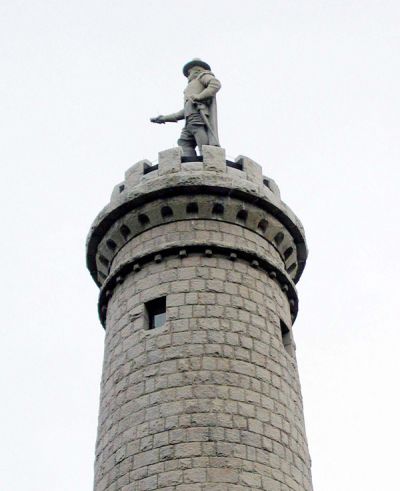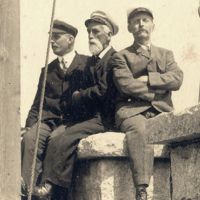Primary Source
"THE PURITAN CAPTAIN."
A GALA DAY AT DUXBURY
Laying of the Corner-Stone of the Myles Standish Monument Yesterday—Military and Civic Procession—Speeches, Etc.
The corner-stone of the monument in process of erection to the memory of Myles Standish was laid in Duxbury yesterday with civic and military honors. Two special trains left this city shortly after nine o'clock yesterday morning, one having on board the Ancient and Honorable Artillery Company and the Masonic fraternity, and the other the invited guests of the Standish Monument Association. These trains arrived in Duxbury a few minutes before eleven o'clock…
After devotional services, conducted by Rev. Dr. Quint of New Bedford, R. W. Grand Chaplain, Gen. Horace Binney Sargent, president of the Monument Association, delivered an eloquent address, concluding as follows: Not only to the memory of Myles Standish, as the type of fearless and honest vigor in public service as soldier and civilian, but also in a reverent spirit of remembrance and grateful honor to the citizen soldiers of New England, from the landing of the Pilgrims to the present hour, do we lay this corner-stone today. . . .
Mr. John McClellan . . . read the inscription and a list of the contents [of the box], which follows:
Programme of the exercises, October 8, 1872; plate and proof, and other papers of the association and history of Myles Standish, also a list of officers of the association; acts and resolves of the State of Massachusetts, 1872; records of the various counties of Massachusetts; History of Duxbury; catalogue of Prince's Library deposited in the Public Library; catalogue of Harvard College; catalogue and other papers of Amherst College; Proceedings of the American Antiquarian Society; Papers from the Massachusetts Historic-Genealogical Society; Catalogue and papers form Tufts College; Catalogue and papers from Brown University; Silver plate of Roster of Ancient and Honorable Artillery Company; List of Officers and Chaplains Ancient and Honorable Artillery Company; List of Officers and other papers of Massachusetts Charitable Mechanic Association; Adjutant General's Report of Massachusetts, 1871; Records of the Companies of the Military of the State; Hingham Journal of October 4, 1872; The Commonwealth, Boston, October 5, 1872; Old Colony Memorial, Plymouth, October 3, 1872; Company C, First Regiment Infantry, M. V. M., Claflin Guard; Concord Artillery and other Military companies of the State of Massachusetts; Current Newspapers fo Massachusetts; Proceedings of the Cable celebration at Duxbury; Many other documents; a piece of our Forefather's Rock….
The Grand Master, after an examination of the stone, declared it square; the box was placed and wedged in position; the block was consecrated with corn, wine and oil, and duly laid by the Grand master according to the form prescribed in the Masonic ritual; the blessing of God was invoked upon the workmen, and the desire expressed that the monument should perpetuate the memory of the pioneer leader whose remembrance it was intended to promote.
A song was then sung to the tune of America, written by Mr. W. T. Adams, and the ceremonies ended. At the conclusion of these the Masons and artillery formed in line and marched down to the foot of the hill by the sea-shore, to participate in a clam-bake. Through some mistake or other the clam-bake was not a success, the clams not being sufficiently cooked. The companies made a very brief stay at the clam–bake and then returned to dinner….
Boston Globe, October 8, 1872.








